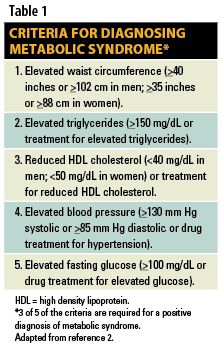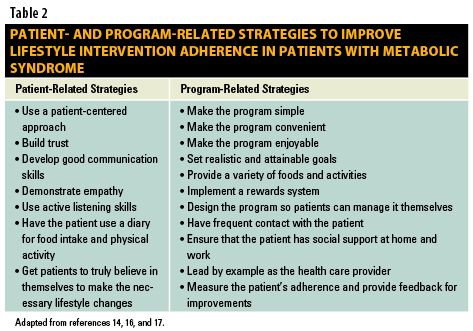Lifestyle Modifications for Patients with Metabolic Syndrome
Pharmacists are in a unique position to inform patients about the various features and proper use of blood pressure monitors.
Pharmacists are in a unique position to inform patients about the various features and proper use of blood pressure monitors.
Introduction
Metabolic syndrome (MetS) has been defined as a “constellation” of metabolic risk factors in one individual.1,2 The age-adjusted prevalence for MetS is estimated to be 23.7%, and as Americans get older the prevalence increases. Individuals with MetS are about 2 times more likely to have coronary heart disease (CHD) compared with persons without MetS after adjusting for established risk factors.3 The prevalence and significance of MetS makes it essential for all health care practitioners, including pharmacists, to have an understanding of these risk factors and the prevention strategies for MetS. The diagnostic criteria for MetS are provided in Table 1.2

Lifestyle modification strategies are foremost in the treatment and prevention of MetS. A great deal of evidence exists to support the use of lifestyle modifications in the treatment and prevention of chronic conditions. These interventions have the potential to decrease the risks of most of the underlying causes of chronic conditions.4 Pharmacists have demonstrated that they can improve drug therapy for patients through medication therapy management (MTM) for chronic diseases such as hypertension, diabetes, and dyslipidemia. However, pharmacists have yet to routinely integrate lifestyle modification strategies into this paradigm. Increasing the awareness and knowledge of lifestyle modification strategies may help pharmacists implement more comprehensive MTM services.
Nutrition
The third publication of the National Cholesterol Education Program, Adult Treatment Panel III guidelines and the American Heart Association/National Heart, Lung and Blood Institute (AHA/ NHLBI) scientific statement on the diagnosis and management of MetS present specific nutritional recommendations for patients with MetS.1,2 Individuals with MetS should be particularly conscious about eating habits that consist of consuming high amounts of saturated fat, trans fat, and cholesterol.
In order for patients with MetS to decrease their risk for cardiovascular disease (CVD), saturated fats should comprise <7.0% of total daily calories, with total fat intake representing 25% to 35% of total calories.2 To limit the intake of saturated fatty acids, the AHA recommends substituting monounsaturated and polyunsaturated fatty acids in their place.5,6 Unsaturated fatty acids have been shown to help reduce the amount of newly formed cholesterol and can help lower blood cholesterol levels when substituted for saturated fatty acids in the diet.1,6
A majority of the calories that are consumed daily should come from carbohydrates (50%-60%). The type of carbohydrate that is consumed, however, is important. Persons with MetS who consume foods with excess dietary refined sugars can experience higher triglyceride levels and adversely affect glucose metabolism.7 Therefore, most of the carbohydrate intake should come from fresh fruits, vegetables, and whole grains. Carbohydrates from these sources increase dietary fiber and have been shown to have a positive effect on CVD prevention.7
Physical Activity
Increased physical activity is one of the cornerstones for the treatment of patients with MetS. Physical activity has been shown to improve lipid profiles, reduce blood pressure, stabilize blood glucose levels, decrease body weight and maintain a healthy body weight, and decrease a patient’s overall risk for CVD.1
The physical activity guidelines published by the US Department of Health and Human Services (USDHHS) recommend that all adults accumulate 150 minutes a week of moderate intensity or 75 minutes a week of vigorous intensity aerobic physical activity, or an equivalent combination.8 Aerobic activity should be performed in episodes of at least 10 minutes, preferably distributed throughout the week. The AHA/NHLBI recommends similar but slightly more specific guidelines for those with MetS.
Because weight loss is one of the primary goals for a patient with MetS, it is recommended that patients with this condition participate in 300 minutes per week of physical activity to most effectively promote weight loss. When counseling patients about exercise, emphasis should be placed on the amount of physical activity, rather than the intensity of the activity, as sedentary people should incorporate greater amounts of physical activity into all aspects of daily life. Accumulating physical activity over the course of a day (ie, walking for 10 minutes, several times a day) is also recommended as an effective alternative to a 1-time exercise session, and may even lead to greater exercise adherence.9,10
Weight Control
Obesity, especially abdominal obesity, has been associated with a higher risk of atherogenicity.11 The goal for patients with MetS is to reduce body weight by 7% to 10% during the first year of weight loss therapy.11 It has been shown that even a modest reduction in body weight can significantly decrease the severity of obesity-related risk factors.11 The Clinical Guidelines on the Identification, Evaluation, and Treatment of Overweight and Obesity in Adults state that it is reasonable to achieve a 10% weight loss in approximately 6 months.11
Once an initial weight loss goal is achieved, reevaluation of the patient’s weight control status is recommended. If further weight loss is warranted, a new weight loss goal should be set and again reevaluated once this new goal is achieved.11 Weight reduction should be accomplished through a combination of increased physical activity, decreased caloric intake, and behavioral modifications. 11 It is important for pharmacists to remind patients that even small amounts of weight loss are associated with significant health benefits.11
Smoking Cessation
It has been known for several decades that smoking is associated with CVD. In 2008, the USDHHS published clinical practice guidelines for smoking cessation. 12 The guidelines strongly recommend that each time a patient is seen by a clinician or health care provider, they be assessed for their use of tobacco.12 Patients willing to try to quit tobacco use should be provided with treatments identified as effective in the guidelines. Patients unwilling to make a quit attempt should be provided with a brief intervention designed to increase their motivation to quit in the future.
This recommendation stems from the evidence that there is a strong dose relationship between the intensity of tobacco dependence counseling and its effectiveness. The greater the number of health care providers—including pharmacists— who talk to a patient about stopping tobacco use and the greater the amount of time spent in the intervention, the more likely the patient is to quit.12 At minimum, pharmacists should routinely ask their patients about their smoking status and if they are willing to make a quit attempt. Pharmacies that do not offer their own tobacco cessation program should refer patients to sources where they can get assistance with quitting.
Health Behavior Change
Several behavior change strategies are available for pharmacists to improve adherence to a lifestyle modification program. Some of the strategies are specific to the patient (patient-related) and some are specific to the program or pharmacist (program-related).
A new scientific statement from the AHA’s Prevention Committee of the Council on Cardiovascular Nursing concludes that behavior change strategies that personalize goals and integrate more than 1 cognitive lifestyle change approach are more likely to be successful than those that focus on just 1 approach. When health care providers and patients establish specific, attainable goals and patients self-monitor their progress, they are more likely to succeed in achieving these goals.13 Table 2 provides a list of examples, with a description of patient-related and program-related behavior change strategies.14,16,17

Implementation into Pharmacy Practice
The addition of lifestyle modification strategies to MTM services offers tremendous opportunity for pharmacists to further enhance patient care. For patients with MetS, lifestyle modification strategies would allow pharmacists to work with patients to provide a comprehensive plan aimed at preventing and/or reducing the adverse outcomes associated with MetS. Screening for at-risk patients (eg, type 2 diabetes, hypertension, dyslipidemia) is an important initial step toward implementation into pharmacy practice. Along with an individualized nutrition, physical activity, weight loss, and tobacco cessation program, pharmacists should consider other lifestyle modification strategies such as stress management, sleep success, and limiting alcohol consumption.
Implementing these types of services may be particularly beneficial in the community pharmacy setting. Nearly one fourth of the US adult population has MetS, so clearly pharmacists have frequent contact with this population. The opportunity to provide health and wellness services could be beneficial to both the patient and the pharmacy. Patients would be provided with a more comprehensive MTM service and a more individualized health and wellness program. The pharmacy could benefit by having patients visit the pharmacy on a more frequent basis, not only to fill prescriptions but to purchase other goods and services. Community pharmacies in supermarket settings may also have access to a dietitian who could further enhance these services through interprofessionalism.
Conclusion
MetS is a constellation of metabolic risk factors that increase the risk of CVD. Lifestyle modification strategies that target behavior changes, nutrition, physical activity, weight reduction, and smoking cessation are preferred for the treatment and prevention of MetS. Pharmacists should consider implementing lifestyle medicine into their existing MTM services for patients with or at risk for MetS to provide a more comprehensive care plan.
Dr. Dull is an assistant professor in the department of pharmacy practice at Creighton University in Omaha, Nebraska. Dr. Lenz is an associate professor in the department of pharmacy practice and director of the Pharmacy Distance Pathway at Creighton University in Omaha, Nebraska. Dr. Monaghan is a professor in and chair of the department of pharmacy practice at Creighton University in Omaha, Nebraska.

